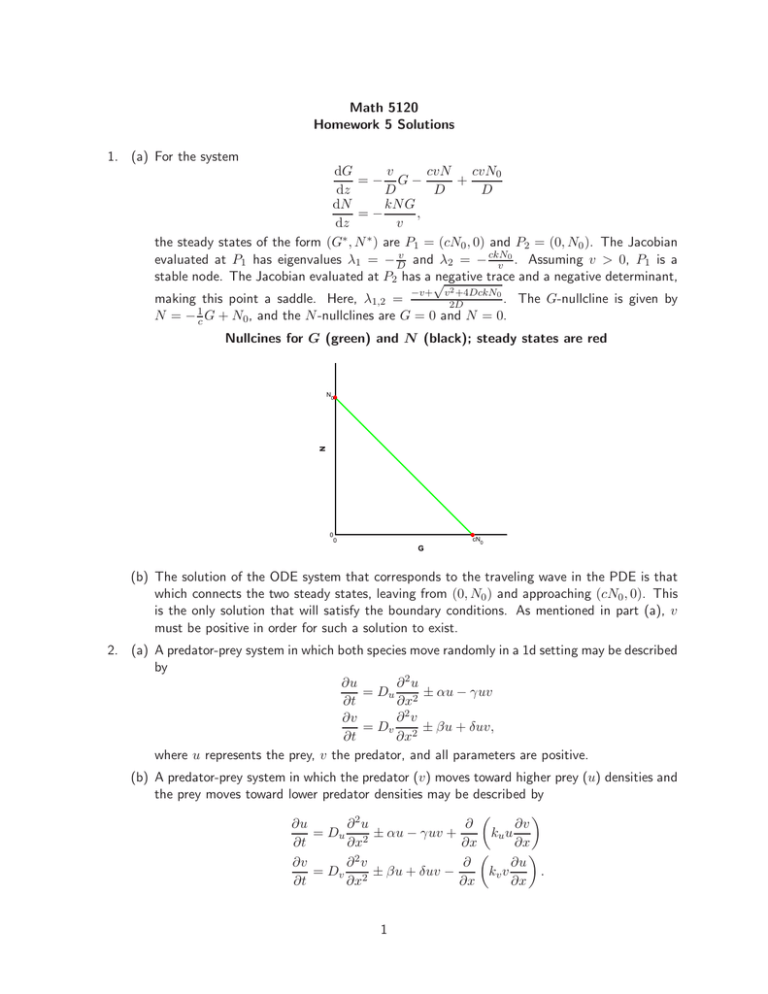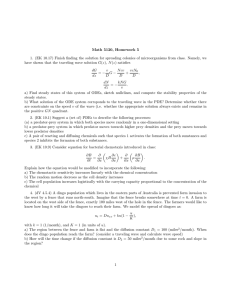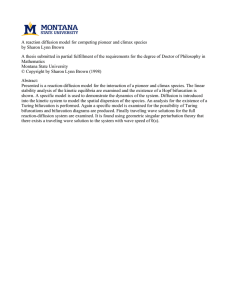Math 5120 Homework 5 Solutions 1. (a) For the system dG
advertisement

Math 5120 Homework 5 Solutions 1. (a) For the system v cvN cvN0 dG =− G− + dz D D D dN kN G =− , dz v the steady states of the form (G∗ , N ∗ ) are P1 = (cN0 , 0) and P2 = (0, N0 ). The Jacobian v 0 and λ2 = − ckN evaluated at P1 has eigenvalues λ1 = − D v . Assuming v > 0, P1 is a stable node. The Jacobian evaluated at P2 has a √ negative trace and a negative determinant, −v+ v2 +4DckN 0 making this point a saddle. Here, λ1,2 = . The G-nullcline is given by 2D 1 N = − c G + N0 , and the N -nullclines are G = 0 and N = 0. Nullcines for G (green) and N (black); steady states are red N N0 0 0 G cN0 (b) The solution of the ODE system that corresponds to the traveling wave in the PDE is that which connects the two steady states, leaving from (0, N0 ) and approaching (cN0 , 0). This is the only solution that will satisfy the boundary conditions. As mentioned in part (a), v must be positive in order for such a solution to exist. 2. (a) A predator-prey system in which both species move randomly in a 1d setting may be described by ∂2u ∂u = Du 2 ± αu − γuv ∂t ∂x ∂2v ∂v = Dv 2 ± βu + δuv, ∂t ∂x where u represents the prey, v the predator, and all parameters are positive. (b) A predator-prey system in which the predator (v) moves toward higher prey (u) densities and the prey moves toward lower predator densities may be described by ∂2u ∂ ∂v ∂u = Du 2 ± αu − γuv + ku u ∂t ∂x ∂x ∂x 2 ∂ v ∂ ∂u ∂v = Dv 2 ± βu + δuv − kv v . ∂t ∂x ∂x ∂x 1 (c) A pair of reacting and diffusing chemicals such that species 1 activates the formation of both substances and species 2 inhibits the formation of both substances may be described by ∂ 2 s1 ∂s1 = D1 2 + α1 s1 − β1 s2 ∂t ∂x ∂ 2 s2 ∂s2 = D2 2 + α2 s1 − β2 s2 , ∂t ∂x where si represents the amount of species i for i = 1, 2. All parameters are assumed to be positive. 3. The original equation for bacterial chemotaxis is ∂B ∂ ∂c ∂ ∂B =− χB + µ . ∂t ∂x ∂x ∂x ∂x (a) If the chemotactic sensitivity increases linearly with the chemical concentration, then the sensitivity term χ will be proportional to c. A modified equation may be ∂ ∂c ∂ ∂B ∂B =− ξcB + µ . ∂t ∂x ∂x ∂x ∂x (b) If random motion decreases as the cell density increases, this can be represented by the inclusion of a decreasing function of B in the diffusion term. An example may be the following: µ ∂B ∂ ∂c ∂ ∂B =− χB + . ∂t ∂x ∂x ∂x B ∂x (c) If the cell population increases logistically with the carrying capacity proportional to the concentration of the chemical, then we can add a logistic term to account for this behavior. A modified equation can be ∂B ∂ ∂c ∂ ∂B B =− χB + µ + rB 1 − . ∂t ∂x ∂x ∂x ∂x kc 4. Given the model u , ut = Duxx + ku 1 − K consider a traveling wave solution such that u(x, t) = ϕ(x − ct). Then with k = 1 and K = 1, the above PDE becomes the following ODE: −cϕ′ = Dϕ′′ + ϕ(1 − ϕ), where ϕ′ denotes the derivative with respect to wave variable z = x − ct. To determine the wave speed, rewrite the second-order ODE as a system two first-order ODEs. ϕ′ = ψ ψ′ = − c 1 ψ − ϕ(1 − ϕ) D D The steady states (ϕ∗ , ψ ∗ ) of this system are P1 = (0, √0) and P2 = (1, 0). The eigenvalues 1 of the Jacobian evaluated at P1 are λ1,2 = 2D (−c ± c2 − 4D). At P2 , the eigenvalues are √ 1 (−c ± c2 + 4D). Therefore, P2 is a saddle and P1 is either a stable node or a stable λ1,2 = 2D 2 spiral for c > 0. Note that if P1 is a stable spiral, then ϕ will oscillate between negative and positive values near the fixed point. Therefore, we require that P1 be a stable node in order for a biologically relevant traveling wave solution to exist in the full system. Subject to this condition, √ it must be the case that c2 − 4D ≥ 0, which implies that c ≥√2 D. Thus, the minimum wave speed that will support traveling waves in this model is c∗ = 2 D. (a) For D = 100, the minimum wave speed is c∗ = 20, and so it will take at least 5 months for the dingo population to reach the farm 100 miles away. √ (b) If, instead, D = 50, the minimum wave speed becomes c∗ = 10 2, and it will take at least 7 months for the dingo population to reach the farm 100 miles away. 3







